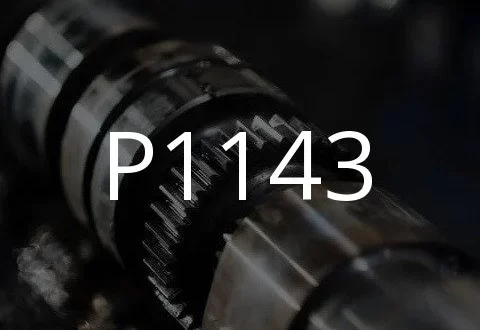
P1143 (Volkswagen, Audi, Skoda, Seat) Car engine load calculation - upper threshold value exceeded
Content
P1143 – OBD-II Trouble Code Technical Description
Trouble code P1143 indicates a problem with engine load calculation in Volkswagen, Audi, Skoda, Seat vehicles.
What does the fault code mean P1143?
Trouble code P1142 indicates a problem with the vehicle's engine load calculation. This means that the engine management system has detected that the measured engine load is higher than the expected maximum level. A load reading that is too high may indicate problems with air or fuel mixing, improper operation of the fuel injection system, or other engine malfunctions.

Possible reasons
Some possible causes of the P1143 trouble code:
- Problems with the mass air flow (MAF) sensor, which measures the amount of air entering the engine and helps calculate the fuel to air ratio.
- Incorrect operation of the fuel injection system, such as problems with injectors or fuel pressure.
- A malfunction of the throttle position sensor (TPS), which detects throttle position and helps the engine management system regulate fuel delivery.
- Problems with the oxygen (O2) sensor, which monitors the oxygen content of exhaust gases and helps the engine management system maintain the optimal fuel-to-air ratio.
- Incorrect operation of the ignition system, such as problems with the spark plugs or ignition coils.
- Problems with the intake system, such as air leaks or a clogged air filter.
- A faulty engine control unit (ECU) may produce incorrect signals or misinterpret data from sensors.
What are the symptoms of a fault code? P1143?
Some typical symptoms that may occur with a P1143 trouble code:
- Loss of power: An unregulated fuel/air mixture can cause the engine to lose power, which means the vehicle may lose speed when accelerating.
- Unstable idle: Incorrect fuel and air mixing can cause rough idle, resulting in shuddering or rough running of the engine at rest.
- Increased fuel consumption: An incorrect fuel/air mixture can result in increased fuel consumption as the engine runs less efficiently.
- Uneven engine operation: In some cases, the vehicle may run unevenly or float in revs, especially when under load.
- Error on the dashboard: When a P1143 code occurs, the Check Engine Light or other light may come on, indicating a problem with the engine management system.
If you experience these symptoms, it is recommended that you contact a qualified mechanic for diagnosis and repair.
How to diagnose a fault code P1143?
When DTC P1143 occurs, the following diagnostic steps are recommended:
- Scan error code: Use a diagnostic scan tool to read the error code from the vehicle's ECU (Electronic Control Unit). Write down the code and any other error codes that may have been found.
- Checking the air filter: Check the condition of the air filter. A clogged or dirty air filter can result in an improper fuel/air mixture, which can cause the P1143 code to appear.
- Checking the Mass Air Flow (MAF) Sensor: The mass air flow sensor measures the amount of air entering the engine. Check its condition and functionality. Clean or replace the sensor if necessary.
- Checking the fuel injection system: Check the operation of the fuel injection system, including the injectors and fuel pressure regulators. Make sure that the injectors are not clogged and are operating properly, and also check for fuel leaks in the system.
- Checking the oxygen (O2) sensor: The oxygen sensor measures the oxygen content in the exhaust gases. Check its operation and replace if necessary.
- Checking the throttle valve: The throttle valve regulates the amount of air entering the engine. Check its operation and clean if necessary.
- Checking wiring and connections: Check the wiring and connections of all the above components for corrosion, breaks or damage.
- Additional tests: Depending on the results of the above steps, additional tests such as fuel pressure measurement or exhaust gas analysis may be required.
If you are unsure of your vehicle diagnostic or repair skills, it is best to contact a qualified auto mechanic for diagnosis and repair.
Diagnostic errors
When diagnosing DTC P1143, the following errors may occur:
- Misinterpretation of data: Sometimes high engine load can be caused by other problems not related to air or fuel mixing. For example, problems with the electrical system, clutch or transmission can also cause increased load on the engine.
- Poor Diagnostics: All sensors related to fuel injection, air flow and fuel pressure must be thoroughly checked to ensure that they are not malfunctioning.
- Wiring faults: Poor connections, short circuits or breaks in the wiring can lead to incorrect data, which may cause misdiagnosis.
- Engine control computer problems: Problems with the engine control module itself can lead to misinterpretation of data and misdiagnosis.
For successful diagnosis, it is necessary to conduct a comprehensive analysis of all possible causes and eliminate them one by one, starting with the most probable.
How serious is the fault code? P1143?
Trouble code P1143 is quite serious because it indicates a problem with the vehicle's engine load calculation. If the measured engine load is higher than the expected maximum level, it can lead to various problems with the operation of the engine and its components. Improper engine performance can affect performance, fuel economy and even driving safety. Therefore, it is recommended to contact a specialist as soon as possible for diagnosis and repair.
What repair will help eliminate the code? P1143?
Troubleshooting the P1143 trouble code requires a detailed diagnosis of the engine management system to determine the specific cause of the problem. Repair may include the following steps:
- Checking the Sensors: The first step is to check the sensors such as the Mass Air Flow (MAF) sensor, Throttle Position Sensor (TPS) and other sensors that may affect the engine load calculation.
- Intake System Check: Check the condition of the intake system for air leaks or air mixing problems.
- Fuel injection system check: Check the functionality of the fuel injection system, including injectors, fuel pressure regulator and other components.
- Electrical System Check: Check the condition of the wiring and electrical connections, including grounding and connections to the engine control computer.
- Software update: Sometimes problems can be caused by errors in the engine control unit software. In this case, the unit may need to be updated or reprogrammed.
Repairs should be performed by a qualified technician using specialized equipment and tools.

